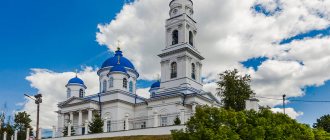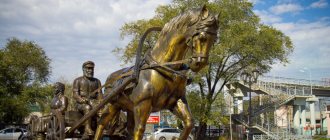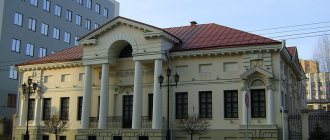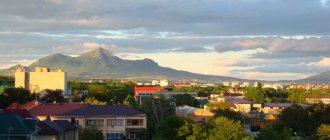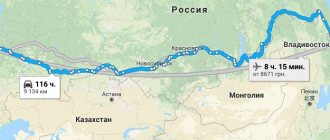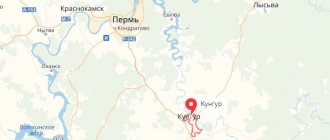- September 20, 2019
- Directions
- Molton
Kazan is a city on the European territory of the country, the capital of the Republic of Tatarstan. This is a large port city. Where is Kazan? This historical and cultural center is located on the left bank of the Volga River, in the area where the Kazanka River flows into it. One of the most successful cities in Russia, a major scientific, educational, cultural, economic, religious and sports center. The city has a long history, dating back over 1000 years. In the past it was the capital of the Kazan Khanate. Kazan is called the “third capital of Russia”.
Kazan gained the greatest fame as a city that has repeatedly hosted international sporting events in various sports. In 2022, a number of matches were held here as part of the FIFA World Cup.
Kazan is an important tourist center. According to this indicator, it ranks 3rd in Europe and 8th in the world. The city is also very popular among Russian tourists.
Kazan is a millionaire city. The number of inhabitants is approximately 1 million 250 thousand people. It is divided into 7 districts. City Day is celebrated on August 30.
Transport
Kazan is one of the most important transport hubs in the country. The city area is crossed by federal highways. There is an international airport, 2 railway stations, 3 bus stations, 1 bus station and a river port.
Public transport includes buses, trolleybuses and trams. The former account for the bulk of traffic. The city has a developed taxi system. An excessive number of private cars worsens the situation on the roads. A feature of public transport in Kazan has been the active transition to natural gas engine fuel. Another specificity is that there are a large number of buses painted bright red on the streets. Therefore, this city began to be called the “city of red buses.”
Population dynamics
| Population | ||||||
| 1557 | 1800[5] | 1811 | 1840 | 1856 | 1858 | 1863 |
| 7000 | ↗40 000 | ↗53 900 | ↘41 300 | ↗56 300 | ↗61 000 | ↗63 100 |
| 1897[6] | 1907 | 1914 | 1917 | 1920 | 1923[7] | 1926[6] |
| ↗130 000 | ↗161 000 | ↗194 200 | ↗206 562 | ↘146 495 | ↗157 600 | ↗179 000 |
| 1931 | 1939[6] | 1956[8] | 1959[9] | 1962 | 1964 | 1966 |
| ↗200 900 | ↗406 000 | ↗565 000 | ↗646 806 | ↗711 000 | ↗742 000 | ↗804 000 |
| 1967[7] | 1970[10] | 1973 | 1975[11] | 1976[12] | 1979[13] | 1982 |
| ↗821 000 | ↗868 537 | ↗919 000 | ↗959 000 | →959 000 | ↗992 675 | ↗1 023 000 |
| 1985[14] | 1986[12] | 1987[15] | 1989[16] | 1990[17] | 1991[12] | 1992[12] |
| ↗1 051 000 | ↗1 060 000 | ↗1 068 000 | ↗1 094 378 | ↘1 094 000 | ↗1 105 000 | ↘1 104 000 |
| 1993[12] | 1994[12] | 1995[14] | 1996[14] | 1997[18] | 1998[14] | 1999[19] |
| ↘1 098 000 | ↘1 092 000 | ↘1 076 000 | →1 076 000 | ↗1 085 000 | ↘1 078 000 | ↗1 100 800 |
| 2000[20] | 2001[14] | 2002[21] | 2003[7] | 2004[22] | 2005[23] | 2006[24] |
| ↗1 101 000 | ↘1 090 200 | ↗1 105 289 | ↗1 105 300 | ↗1 106 900 | ↗1 110 000 | ↗1 112 700 |
| 2007[25] | 2008[26] | 2009[27] | 2010[28] | 2011[29] | 2012[30] | 2013[31] |
| ↗1 116 000 | ↗1 120 238 | ↗1 130 717 | ↗1 143 535 | ↗1 145 424 | ↗1 161 308 | ↗1 176 187 |
| 2014[32] | 2015[33] | 2016[34] | 2017[2] | |||
| ↗1 190 850 | ↗1 205 651 | ↗1 216 965 | ↗1 231 878 | |||
Economy
Kazan is an important industrial, commercial, financial and tourist center of the Russian Federation. The construction industry is very developed here. The economy is based on mechanical engineering, food processing, chemistry and petrochemistry, and light industry. The country's largest IT and technology park is located on the territory of Kazan. There is a large-scale program for the elimination of dilapidated housing.
The city ranks first in the country in terms of the number of modern shopping centers per unit of population.
Over 1 million tourists visit Kazan every year. The Kazan Kremlin is the most popular. There are 161 hotels available to visitors, and for 1000 people. accounts for 7.4 numbers.
About Kazan
Kazan
- a city located on the left bank of the Volga River, the capital of the Republic of Tatarstan, an important economic and cultural center of Russia. This is not only an ancient city with a long history, but also a meeting place between Europe and Asia, Orthodoxy and Islam.
There are several legends associated with the name of the city.
According to the most common of them, “Kazan” comes from the Tatar word “kazan” - cauldron. Legend has it that the city was founded on the spot where water boiled in a cauldron dug into the ground without fire. The symbol of the city, depicted on the coat of arms, is the mythical dragon-like creature Zilant. At different times, the city was part of the Volga Bulgaria, the Golden Horde, the Muscovite Kingdom, the Russian Empire and the USSR. So, more than 1000 years ago, a fortress was built in the northern part of Volga Bulgaria, in which trade caravans from Kievan Rus, the Byzantine Empire and the Middle East converged into one hub. The age of the city was determined during excavations on the territory of the Kazan Kremlin, when a Czech coin dated 929-930 was found, as well as the remains of masonry and a wooden city fence, and utensils.
In 1438, the citadel built by the Bulgars fell under the onslaught of the troops of the Golden Horde Khan Ulu-Muhammad - the city became the capital of the Kazan Khanate. This period was marked by the establishment of trade relations with Moscow, Crimea, Turkey and other regions. Kazan is actively developing, turning into an important trade and political center as part of the Golden Horde state. The favorable geographical location at the intersection of major trade routes contributed to the prosperity of the territory. In Russian chronicles, Kazan begins to be mentioned in the 14th-15th centuries. An important milestone was the start of minting their own coins.
The formation of Kazan was accompanied by military conflicts. After a series of disputes with the Principality of Moscow, the troops of Ivan the Terrible captured Kazan in 1552, most of the city was destroyed, and the Tatars were resettled on the marshy shores of Lake Kaban, where the Old Tatar Settlement was subsequently formed. After the final suppression of the uprisings in the Kazan region, the city entered a new era associated with the Russian state.
The history of Kazan as part of the Russian Empire has many significant dates: the construction of the white-stone Kremlin, the foundation of the first manufactories and craft settlements. Rapid economic growth led to the fact that in 1708 Kazan became the capital of the Kazan province. Over time, Imperial Kazan received a city Duma, a city coat of arms, a general development plan, a Town Hall, a permanent theater, an observatory, public transport, a telegraph and a water supply system. In 1804, Kazan University was opened, the most famous students of which are Vladimir Lenin and Leo Tolstoy.
The beginning of the 20th century is associated with great upheavals that Kazan experienced, becoming one of the centers of the revolution. Revolutionary unrest gave way to fierce fighting during the civil war. In 1920, the Tatar Autonomous Soviet Socialist Republic was formed with its capital in Kazan. In the 1930s, intensive industrialization of the city began, accompanied by rapid population growth and expansion of the trans-river part of the city.
During the Great Patriotic War, Kazan was the rear support of the country, where large factories and research centers found temporary shelter. After the war, the city continued to develop, becoming one of the largest industrial, scientific and cultural centers of the country with a population of over a million people. The city acquired one of the largest river ports and received a new airport.
The modern history of Kazan began in 1990, when it became the main city of the Republic of Tatarstan. The celebration of the millennium in 2005 marked a colorful page in the history of the city. Significant objects were built in the city - the metro, the Kul-Sharif mosque, the Millennium Bridge, the new hippodrome, the Tatneft Arena and other large structures. In 2008, Kazan was declared the third capital of the Russian Federation, the “sports capital” and the “global capital of the Tatars”. The rapid development of the city did not go unnoticed - Kazan began to be visited by about a million tourists a year. The capital of Tatarstan acquired the status of an important domestic tourism center, and the Kremlin became a UNESCO monument.
As of January 1, 2022, 1 million 257 thousand 341 people live in Kazan. The city continues to actively develop, delighting its citizens and attracting new tourists.
Between East and West
Kazan is one of the striking examples of how people of different nationalities and religions live peacefully in one city in an atmosphere of friendliness and tolerance. Ethnic and religious diversity in the capital of Tatarstan has been preserved for centuries. 136 places of worship: 70 mosques, 45 Orthodox churches, 5 Old Believer places of worship, 13 churches of other Christian denominations, 1 synagogue, Bahai and Krishna prayer houses.
Representatives of over 115 nationalities live in the capital of Tatarstan. The most numerous of them according to the 2010 population census are Russians (48.6%) and Tatars (47.6%). Also among the residents of Kazan you can meet Chuvash, Ukrainians, Mari, Bashkirs and Udmurts.
Kazan – educational center
Kazan is a youth city with a scientific and educational center. In 2019, the city welcomed participants of the world championship in professional skills “WorldSkills”.
The opportunity to receive affordable and high-quality higher education attracts nonresident and foreign applicants to the capital of Tatarstan.
Future students can choose any of 30 universities (13 public, 9 commercial, 8 university branches), and 32 professional educational institutions are also at their service. One of the oldest universities in the country is the Kazan (Volga Region) Federal University, founded in 1804 and famous for its scientific school.
From Chaliapin to the present day
Kazan has a unique cultural code. On the city map there are more than 1000 objects that form the cultural diversity of the capital.
The city has open doors to 34 museums, 9 theaters, 8 large concert halls, 16 palaces of culture, 51 libraries and 50 children's art schools. New cultural venues are constantly being formed in Kazan, for example, the creative space “Headquarters”, the Center for Contemporary Art “Smena”, and the creative laboratory “Ugol”.
Kazan is known throughout the country for its international forums: the F.I. Chaliapin Opera Festival, the R. Nuriev Classical Ballet Festival, the Muslim Film Festival, and the Nauruz Theater Festival of Turkic Peoples. Russia's leading theaters and world-famous stars traditionally include Kazan in their tour route, and the city's museums periodically exhibit exhibits from the Hermitage, Tretyakov Gallery and the Russian Museum.
In 2022, Kazan joined the UNESCO network of creative cities in the field of music.
Kazan is the sports capital of Russia
The city with a thousand-year history is young in spirit, being the center of students and sports.
The XXVII World Summer Universiade in 2013 became a “golden” page in the history of the city, the legacy of which made it possible to host the XVI FINA World Aquatics Championship in 2015, FIFA Confederations Cup matches in 2022, and FIFA World Cup matches in 2022.
The city's sports infrastructure includes 15 stadiums, 15 indoor ice arenas, 67 swimming pools, 385 gyms and 596 flat sports fields.
A real gem of the city is the 45,000-seat Kazan Arena football stadium (since 2022, renamed Ak Bars Bank Arena) - the first stadium in Russia built to host the 2022 World Cup. In 2013, the opening and closing ceremonies of the World Summer University Games were held at the Kazan Arena. In 2015, the stadium hosted swimming and synchronized swimming competitions as part of the World Aquatics Championships. In 2017, Kazan Arena hosted 4 Confederations Cup matches, and in 2022 – six FIFA World Cup matches. The Kazan football club Rubin plays its home matches at the stadium. Games of the Russian national team and Eurocup matches also took place here.
In addition to organizing mega-events in Kazan, the development of sports is ensured not only at the regional, but also at the all-Russian level, federal sports and training centers are opened (Rowing Sports Center, Gymnastics Center, Tennis Academy, etc.), specialized higher educational institutions (Volga Region State Academy of Physical culture, sports and tourism and a new educational Campus on the territory of the Olympic Village of the 2013 Universiade), conditions are created for the training of champion clubs (hockey club "AK Bars" and football club "Rubin").
Thanks to the quantity and quality of sports facilities, their compliance with international standards, the capital of Tatarstan can successfully compete with other largest cities in the country and the world for organizing the largest sports competitions on its territory.
Priority is given to public transport
The transport network of Kazan, according to Russian and foreign experts, is one of the most modern and convenient in Russia. Priority in the city is given to public transport, while the capital of Tatarstan was the first in Russia to introduce a dedicated lane on the roads for buses and trolleybuses. Now Kazan ranks first in the unofficial ranking of Russian cities in terms of the length of dedicated lanes for public transport. In the capital of Tatarstan, there are 155.7 m of dedicated lanes per 1,000 people.
According to the results of a study by the Scientific Research Institute of Automobile Transport (NIIAT), which is developing a new transport service system for Kazan, the capital of Tatarstan took first place in terms of efficiency in using the route network. There are 4 types of passenger transport in Kazan - tram, trolleybus, bus and metro. As for the latter, the Kazan metro is the “youngest” of the Russian metro systems. The opening of the first section in 2005 was timed to coincide with the 1000th anniversary of the city. Today the system consists of a single central line with 11 stations.
Millions of tourists per year
Kazan began its ascent to the tourism Olympus in 2005, when the capital of Tatarstan celebrated its millennium.
In the anniversary year, the city was visited by 500 thousand guests, in the year of the Universiade, Kazan received 1.5 million guests, in the year of the World Aquatics Championships - 2.1 million, in 2016 - 2.5 million, and in the year of the championship World Football Championship, the capital of Tatarstan received its three millionth tourist. By 2030, Kazan is preparing to welcome its 5 millionth tourist. The most visited places among tourists are the Kazan Kremlin, Bauman Street, the Kremlin embankment and the Kaban lake embankment, the Riviera water park and other attractions.
Under the protection of UNESCO
In Kazan, 565 objects are under state protection as objects of cultural heritage (historical and cultural monuments), of which 126 are of federal significance, 371 of republican significance and 68 of local significance. In 2000, the Kazan Kremlin ensemble was added to the UNESCO World Heritage List.
In order to preserve ordinary historical buildings, surrounded by monuments, Kazan was included in the list of historical settlements. More than 400 objects are to be preserved without changing their stylistic features. Thus, the unique historical heritage of Kazan will be preserved for its future generations.
"Lungs" of the city
Special attention is paid to parks and squares in Kazan. Over the past 10 years, since 2011, with the support of the republic and the federal center, 99 recreation centers have been updated and created from scratch in Kazan. Today in Kazan there are 145 parks and squares with a total area of 432 hectares. Residents especially loved the Gorkinsko-Ometyevsky Forest Park, Gorky Park, Black Lake Park, Pine Grove Park and Victory Park.
Parks and squares in Kazan are not only a quiet place to relax, but also areas for active cultural and sports leisure for city residents. Festivals, film screenings, concerts, and charity fairs breathed life into the renovated public spaces.
High technology trend
Kazan's leadership in the economic sphere is clearly visible. The capital of Tatarstan occupies a leading position in investment and construction in the Volga region, in the provision of modern shopping centers and in the total capital of its own banks in Russia. The city is home to Russia's largest technopark in the field of high technologies, IT Park, as well as one of the largest technoparks in Europe, Idea.
Since 2007, the Kazan City Hall has been implementing a large-scale program for the development of small businesses. There are preferential lending and rental programs for municipal property for businessmen.
Attractions
Where are the attractions in Kazan? Mostly in the city center. There are many beautiful architectural buildings there. Among them are the Palace of Farmers, the Kazan Kremlin, Bauman Street, the monument to the compass, and the Kul Sharif Mosque. A very unusual object is a monument to the Tatar pie echpochmak. This triangular symbol of Tatar cuisine is made in huge sizes and looks almost like the real thing.
The monument to Musa Jalil shows a proud and strong-willed man. This is a large stone sculpture located in front of the entrance to the Kremlin.
Section 2. Characteristic features of the local climate
Let's open a map of Russia or pick up a globe and find out where Kazan is located. Taking a closer look, let's try to guess what the features of the local weather are at different times of the year. Due to the close proximity of mountains and forest-steppe, the climate is temperate continental with mountain elements. Summer is usually warm, and the temperature in July, according to experts, is slightly above +19 °C. In winter, Kazan is moderately cold. The average January temperature is -12.4 °C. It rains frequently in autumn and spring, and the annual precipitation rate is approximately 600 mm.
Migration
The birth rate far exceeds the number of immigrated citizens. Last year, 2022, there was a minimal jump in immigration, amounting to only 3,600 people. Over 9 years is considered the minimum figure. The flow of migrants has stopped.
Foreigners who received citizenship came from the countries: Ayzerbanzhan, Yerevan, Kalmykia, Spain, Italy. There are very few citizens who left their homeland; there are a large number of families who received maternity capital, which indicates a high standard of living. There was a time when the number of migrants exceeded the number of births; fortunately, everything has changed now.
Data for the Republic of Tatarstan
Gender and age
In the capital, the number of women predominates several times. According to demographic data, the number of the male half is 10 times less and is equal to 44.6%, the female half is 55.4%. It’s easy to summarize: there are 10 times fewer living men than women. Another situation: for every 1000 men, there are 1241 women. There are about 300,000 children in the republic. Total number of people of disabled age. Most of the population is young compared to other populated areas of the Russian Federation. The average life expectancy for men is 67 years, for women – 71 years.
Voronezh | 596 sq. kilometer
In 9th place in the top 10 largest Russian cities is Voronezh with an area of 596.51 square meters. kilometer The population is 1.3 million inhabitants. The city is located in a beautiful place - on the banks of the Don and the Voronezh reservoir. Voronezh has many beautiful architectural monuments, but it is also famous for its modern art. Sculptures of the kitten from Lizyukova Street, a character from the famous cartoon, and White Bim from the film “White Bim, Black Ear” were installed in the city. There is also a monument to Peter I in Voronezh.
Location
If you wonder where the city of Kazan is located on the map, it is more convenient to use the “2 GIS” service or a map in any Internet search engine. The metropolis is located in the central part of the Russian Federation. The city is divided by the Kazanka River, which flows into the wide “artery” of the state, the Volga.
Kazan is separated from the capital of Russia by a route 820 km long in an eastern direction. The city shares the same time zone with Moscow. Kazan annually attracts a huge number of tourists from different parts of the world.
Orsk | 621 sq. kilometers
Orsk , which includes three administrative districts with an area of about 621.33 square meters. kilometers, takes seventh place in the list of the largest Russian cities. It is located in a picturesque place - on the spurs of the majestic Ural Mountains, and the Ural River divides it into two parts: Asian and European. The main industry developed in the city is industry. There are more than 40 archaeological sites in Orsk.
Volgograd | 859 sq. kilometers
The hero city of Volgograd , which in the Soviet era was named Stalingrad, ranks third on the list of the largest Russian cities. Area – 859,353 sq. kilometers. The population is just over a million people. The city was founded at the end of the 16th century on the ancient Volga trade route. The first name is Tsaritsyn. One of the most famous historical events associated with Volgograd is the great Battle of Stalingrad, which showed the courage, heroism and tenacity of Russian soldiers. It became a turning point in the war. One of the most famous monuments dedicated to those difficult years is the “Motherland Calls” monument, which became its symbol for the city residents.
The magic of the third capital
The metropolis is often called the third capital and for good reason. Different peoples besides the indigenous Tatars coexist harmoniously in it. The Udmurts, Chuvash, Russians and other cultures settled here long ago, bringing their own “zest” of life and traditions. The national flavor, diluted with the bright harmony of a mixture of cultures, attracts tourists who want to unravel it.
Kazan is a rich region that reflects life in all regions of Tatarstan. Oil outlets allow the republic to set affordable prices in stores and stably develop the economy. A lot has been built for the convenience and comfort of the population and travelers for the 2013 Universiade.
In particular, new suburban railway and air terminals appeared, and the station for long-distance trains was updated. This region of Russia is full of cultural and historical heritage sites that are worth coming here for.
The developed infrastructure with an abundance of shopping malls, business centers, and universities is complemented by a convenient transport interchange connecting the city with Mari El and the cities of the Volga region.
From the central bus station, located near the River Port, buses depart throughout Russia and to neighboring countries. What is important for a traveler to know about climate conditions when planning a trip?
Tyumen | 698 sq. kilometers
In sixth place among the largest settlements in Russia is the first Russian city founded in Siberia - Tyumen. The number of inhabitants is about 697 thousand people. Territory – 698.48 sq. kilometers. Founded in the 16th century, the city now includes 4 administrative districts. The beginning of the future city was laid by the construction of the Tyumen fort, started by decree of Fyodor Ivanovich, the third son of Ivan the Terrible.
